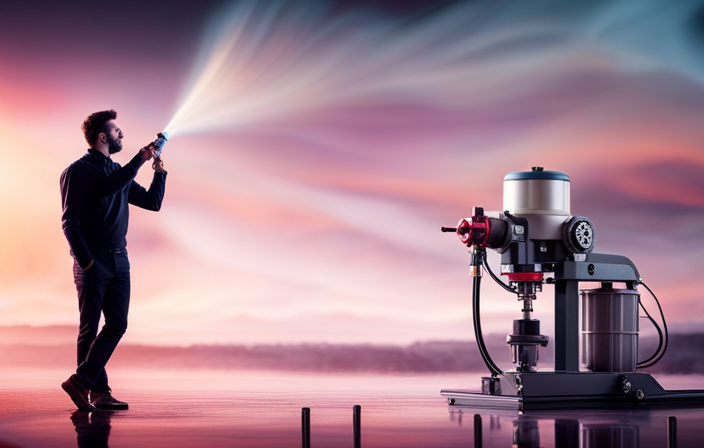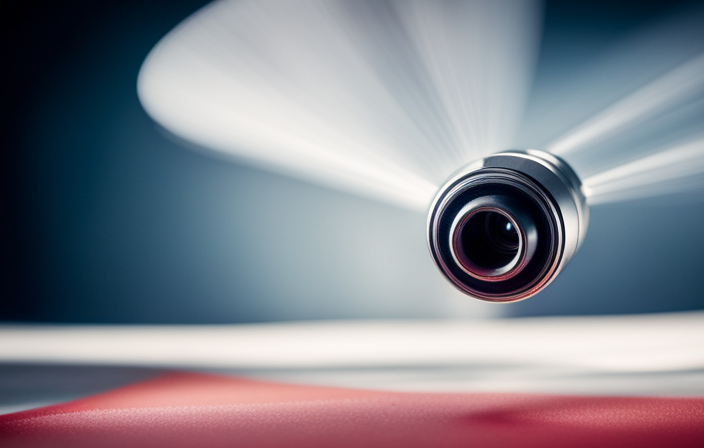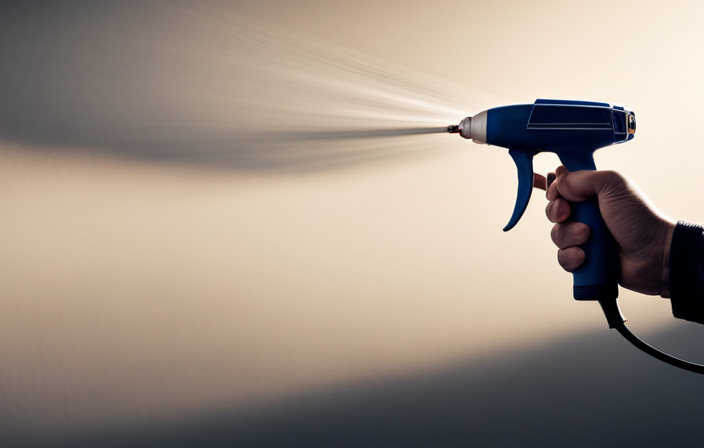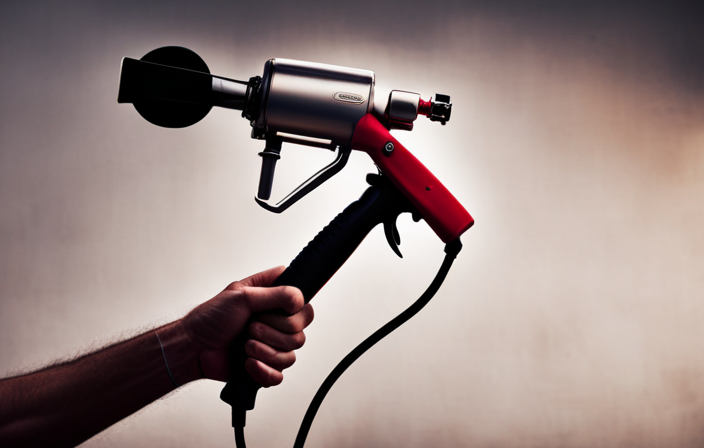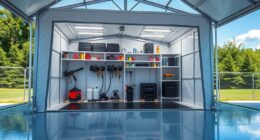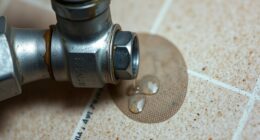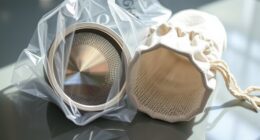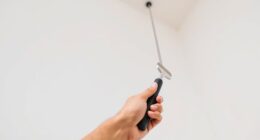As a fan of DIY projects, I have often found myself intrigued by the functionality of an airless paint sprayer. It’s like having a magic wand that can effortlessly transform dull walls into vibrant works of art. So, let’s explore the world of airless paint sprayers and uncover the secrets behind their exceptional performance.
Unlike traditional paint sprayers that rely on compressed air, airless sprayers use a hydraulic pump system to deliver paint at high pressure. This pressure forces the paint through a small opening in the spray gun nozzle, atomizing it into a fine mist. This mist then coats the surface evenly, giving you a smooth and professional finish every time.
In this article, we’ll explore the inner workings of airless paint sprayers, from understanding the hydraulic pump system to achieving a fine spray pattern. We’ll also discuss important tips for proper paint application, maintenance, and troubleshooting. By the end, you’ll have all the knowledge you need to choose the right airless paint sprayer for your next project.
So, let’s get started and unlock the secrets of this incredible tool.
Key Takeaways
- Airless paint sprayers use hydraulic pump systems to deliver paint at high pressure, allowing for a wide range of paint thicknesses without thinning.
- The pressure control knob on the sprayer adjusts the paint flow rate, determining the amount and speed of paint application.
- The hydraulic pump system ensures steady and consistent paint flow, contributing to an even coating and atomization of the paint particles.
- Proper maintenance and cleaning of airless sprayers are essential for optimal performance, longevity, and preventing clogs or issues.
The Basics of Airless Paint Sprayers
If you’re looking to achieve professional-level paint finishes without the hassle of traditional paint brushes or rollers, then you’ll want to know how an airless paint sprayer works.
Unlike traditional sprayers that rely on compressed air to atomize paint particles, airless sprayers use a hydraulic pump to pressurize the paint and force it through a small tip. This creates a high-velocity spray that evenly coats surfaces with paint.
One advantage of airless sprayers is that they can handle a wide range of paint thicknesses, from thin stains to thick latex paints, without the need for thinning. However, it’s important to note that different paint thicknesses may require adjustments to the pressure settings on the sprayer.
Understanding the hydraulic pump system is crucial for proper operation and maintenance of an airless paint sprayer.
Understanding the Hydraulic Pump System
The operation of the hydraulic pump system in an airless paint sprayer is essential for achieving efficient and precise application of coatings. The hydraulic pump generates the necessary hydraulic pressure to move the paint from the reservoir to the spray gun. This pressure is controlled by a pressure control knob, allowing for adjustments to the paint flow rate. By increasing or decreasing the pressure, the operator can control the amount of paint being sprayed and the speed at which it is applied. The hydraulic pump system ensures a steady and consistent flow of paint, resulting in an even and uniform coating on the surface. This system plays a crucial role in achieving optimal paint application and ensuring a high-quality finish. Moving on to the next section, we will explore the role of pressure in atomizing paint.
The Role of Pressure in Atomizing Paint
Pressure plays a pivotal role in creating a fine mist of paint particles, allowing for better coverage and a smoother finish. Here’s how pressure contributes to the atomization of paint:
-
Increased pressure: As the paint is forced through the system at high pressure, it passes through a small nozzle orifice. This increase in pressure causes the paint to break up into tiny droplets, creating a mist-like spray pattern.
-
Size control: The pressure can be adjusted to control the size of the paint particles. Higher pressure results in smaller particles, while lower pressure produces larger droplets. This allows for customization based on the desired finish and application requirements.
-
Even distribution: The pressure ensures that the paint particles are evenly distributed across the surface being painted. This helps to eliminate streaks or uneven coverage, resulting in a professional-looking finish.
Transitioning into the next section about exploring the spray gun and nozzle, we can delve into the components that contribute to the atomization process.
Exploring the Spray Gun and Nozzle
When using a spray gun and nozzle, it’s fascinating to explore how these components contribute to the atomization process. Spray gun maintenance is crucial for achieving optimal performance. Regular cleaning and lubrication help prevent clogs and ensure smooth operation.
It’s also important to check for any loose parts or damaged seals that could affect the spray pattern. Nozzle selection plays a significant role in achieving the desired results. Different nozzle sizes and shapes determine the spray pattern width and thickness. Choosing the right nozzle for the paint viscosity and desired finish is essential.
Additionally, nozzle wear can affect the spray pattern, so it’s important to replace worn-out nozzles. Understanding the importance of spray gun maintenance and proper nozzle selection is key to achieving a fine spray pattern, which will be discussed in the next section.
Achieving a Fine Spray Pattern
To truly appreciate the beauty of a finely atomized spray pattern, it’s all about understanding the art behind achieving it. Achieving consistent coverage and controlling overspray are key factors in achieving a fine spray pattern with an airless paint sprayer. To help visualize this process, let’s take a look at a 3 column by 5 row table:
| Distance from Surface | Spray Pattern Width | Spray Pattern Shape |
|---|---|---|
| Close proximity | Narrow | Circular |
| Medium range | Medium | Elliptical |
| Far distance | Wide | Fan-shaped |
| Close proximity | Narrow | Circular |
| Medium range | Medium | Elliptical |
By adjusting the distance from the surface, we can control the width and shape of the spray pattern. This allows for consistent coverage and minimizes overspray. With a fine spray pattern achieved, let’s explore the advantages of airless paint sprayers.
Advantages of Airless Paint Sprayers
One of the greatest benefits of using airless paint sprayers is their ability to quickly and efficiently cover large surface areas. This makes them highly cost-effective and increases overall efficiency.
Unlike traditional paint brushes or rollers, airless sprayers use high pressure to atomize the paint into small droplets, which are then evenly distributed onto the surface. This results in a smooth and even finish, with no brush marks or streaks.
Additionally, airless sprayers can handle a wide range of coating materials, from thin stains to thick latex paints. They also have a fast application rate, allowing for quicker completion of projects.
Overall, the advantages of airless paint sprayers make them a popular choice for both professional painters and DIY enthusiasts. With their cost-effectiveness and increased efficiency, they’re a valuable tool for any paint project.
Moving on to tips for proper paint application, it’s important to…
Tips for Proper Paint Application
For a flawless finish, make sure you have the right equipment and prepare the surface properly before applying the paint. When using an airless paint sprayer, it’s essential to consider the paint thickness and surface preparation for optimal results. Here are some tips to help you achieve a professional paint application:
-
First, make sure the paint is the right consistency for the sprayer. Thin the paint if necessary, following the manufacturer’s guidelines.
-
Clean the surface thoroughly, removing any dirt, grease, or loose paint. This will ensure proper adhesion and a smooth finish.
-
Use a primer if needed, especially on bare surfaces or when painting over a different type of paint.
-
Apply the paint in thin, even coats, overlapping each pass to avoid streaks or uneven coverage.
By following these tips, you can ensure a successful paint application with an airless sprayer.
Now, let’s move on to the next section about the maintenance and cleaning of airless sprayers.
Maintenance and Cleaning of Airless Sprayers
Regular maintenance and cleaning of your airless sprayer is like giving your trusty steed a well-deserved grooming session to keep it performing at its best.
To ensure optimal performance, it’s essential to follow certain maintenance techniques. First, always inspect the sprayer for any signs of damage or wear before and after each use.
Clean the filters regularly, as clogged filters can affect the spray pattern. Use recommended cleaning agents, such as mineral spirits or water-based solutions, to remove any paint residue.
Pay special attention to the gun tip and nozzle, as these areas are prone to clogging. Additionally, lubricate the pump and other moving parts to prevent friction and extend their lifespan.
By regularly maintaining and cleaning your airless sprayer, you can avoid common troubleshooting issues and keep your painting projects running smoothly.
Common Troubleshooting Issues and Solutions
Experiencing frustrating issues with your trusty airless sprayer? Fear not! Let’s uncover common troubleshooting problems and their simple solutions. When troubleshooting your airless paint sprayer, it’s important to first identify the problem. Here are some common problems you may encounter and the techniques to fix them:
| Problem | Possible Solution |
|---|---|
| Clogged Spray Tip | Remove the tip and clean it thoroughly with a brush or solvent. |
| Uneven Spray Pattern | Check the fan and adjust it to the desired width. Also, ensure that the paint viscosity is correct. |
| Loss of Pressure | Check for any leaks in the hose or connections. Also, make sure the pump is properly primed. |
These troubleshooting techniques should help you resolve most issues with your airless sprayer. Now that your sprayer is working smoothly, let’s move on to the next step: choosing the right airless paint sprayer for your needs.
Choosing the Right Airless Paint Sprayer for Your Needs
When it comes to selecting the perfect airless paint sprayer for your needs, it’s like finding the right brush for a painter – it’s all about finding the tool that feels comfortable in your hand and allows you to create the smoothest strokes.
One important factor to consider is selecting the right paint type. Different sprayers may have different capabilities when it comes to handling different types of paint, such as latex or oil-based paint. It’s essential to choose a sprayer that can handle the specific paint you plan to use.
Another crucial aspect is the ability to adjust spray patterns. This feature allows you to control the width and intensity of the spray, giving you more flexibility in achieving the desired finish. Look for a sprayer that offers easy adjustment options to suit your painting needs.
Frequently Asked Questions
Is an airless paint sprayer suitable for all types of paint?
Yes, an airless paint sprayer is suitable for all types of paint. It offers compatibility with various paints, including latex, oil-based, and acrylic. Its high-pressure system ensures efficient and even coverage on any surface.
What safety precautions should be taken when using an airless paint sprayer?
When using an airless paint sprayer, it’s crucial to take safety precautions. Proper ventilation is essential to prevent inhaling fumes. Remember, 50% of accidents occur due to lack of safety measures. Stay safe and ventilated!
Can an airless paint sprayer be used for small touch-up jobs?
Yes, an airless paint sprayer can be used for small touch-up jobs. It offers efficient and precise paint application, making it a convenient choice. However, touch-up techniques and alternative tools can also be used for smaller areas.
How long does it take for the paint to dry when using an airless paint sprayer?
When using an airless paint sprayer, the paint drying time can vary depending on factors like temperature and humidity. In my experience, on a warm and dry day, it took about 2-4 hours for the paint to dry completely.
Can an airless paint sprayer be used to paint textured surfaces?
Yes, an airless paint sprayer can be used to paint textured surfaces. It is important to adjust the painting techniques to accommodate the texture. However, there are alternative tools specifically designed for textured surfaces that may be more effective.
Conclusion
In conclusion, using an airless paint sprayer is like unleashing an artistic tornado. It’s hydraulic pump system and high-pressure atomization transform paint into a fine mist, creating a beautiful spray pattern on any surface. Proper maintenance and cleaning are essential to keep this powerful tool running smoothly. Remember to choose the right sprayer for your specific needs. So, buckle up and let the whirlwind of creativity take flight as you paint your world with precision and ease.
